AUDI R8 SPYDER 2015 Owners Manual
Manufacturer: AUDI, Model Year: 2015, Model line: R8 SPYDER, Model: AUDI R8 SPYDER 2015Pages: 232, PDF Size: 58.36 MB
Page 101 of 232
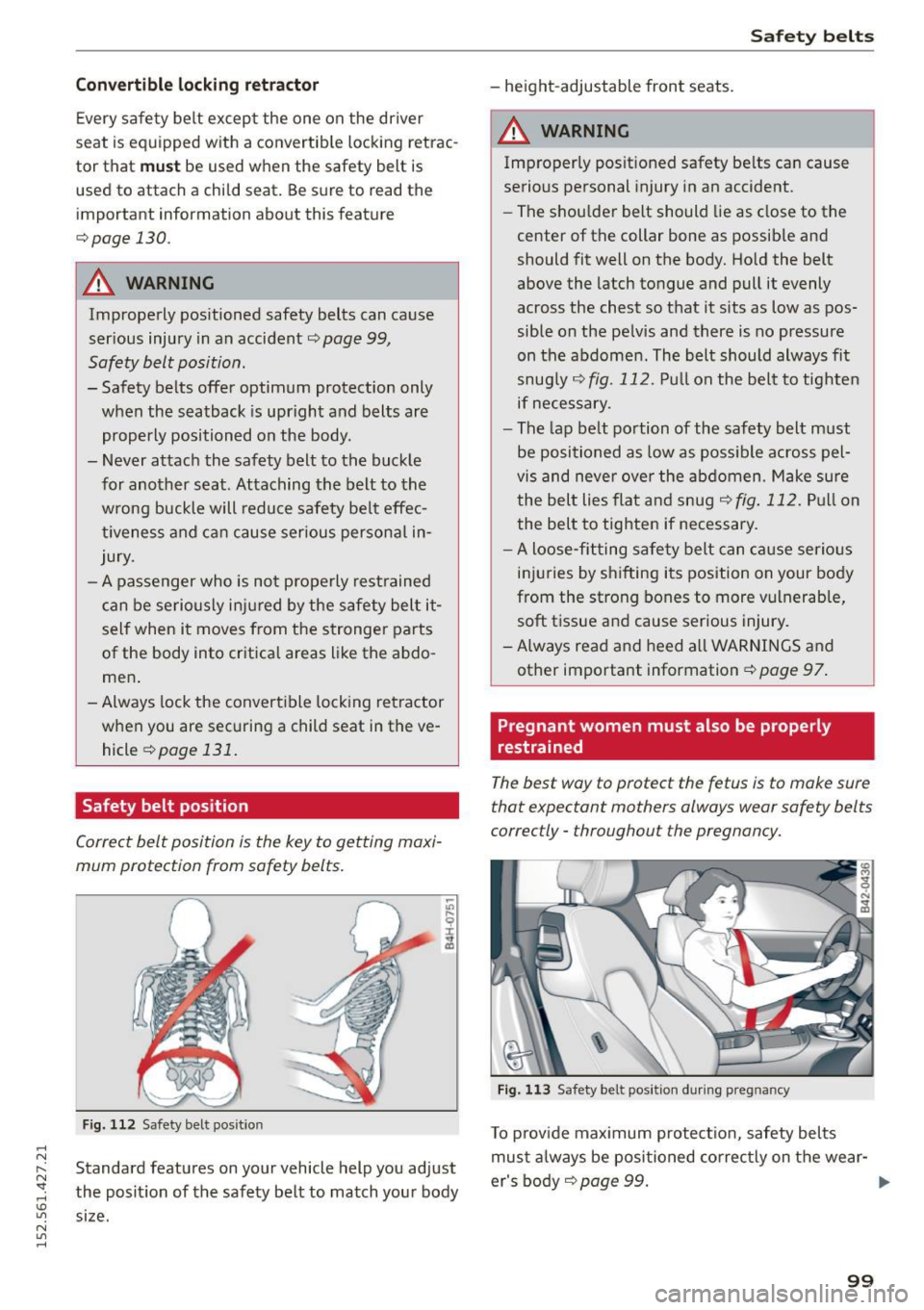
.... N
l'
N "1: rl I.O
"' N
"' ....
Convertible locking retractor
Every safety belt except the one on the driver
seat is equipped with a convertible locking retrac
tor that
must be used when the safety belt is
used to attach a child seat. Be sure to read the
important information about this feature
c::;,page 130.
A WARNING
Improperly positioned safety belts can cause
serious injury in an accident
c::;, page 99,
Safety belt position.
- Safety belts offer optimum protection only
when the seatback is upright and belts are
properly positioned on the body.
- Never attach the safety belt to the buckle
for another seat. Attaching the belt to the
wrong buckle will reduce safety belt effec
tiveness and can cause serious personal in
jury .
- A passenger who is not properly restrained
can be seriously injured by the safety belt it
self when it moves from the stronger parts
of the body into critical areas like the abdo
men .
- Always lock the convertible locking retractor
when you are securing a child seat in the ve
hicle
c::;, page 131.
Safety belt position
Correct belt position is the key to getting maxi
mum protection from safety belts.
Fig. 112 S afety be lt pos it io n
Standard features on your vehicle help you adjust
the position of the safety belt to match your body
size .
Safety belts
-height -adjustable front seats.
A WARNING
Improperly positioned safety belts can cause
serious personal injury in an accident .
- The shou lder belt should lie as close to the
center of the collar bone as possible and
should fit well on the body. Hold the belt
above the latch tongue and pull it evenly
across the chest so that it sits as low as pos
sible on the pelvis and there is no pressure
on the abdomen. The belt should always fit
snugly
<> fig. 112. Pull on the belt to tighten
if necessary.
- The lap belt portion of the safety belt must
be positioned as low as poss ible across pel
vis and never over the abdomen. Make sure
the belt lies flat and snug
c::;, fig. 112 . Pull on
the belt to tighten if necessary.
- A loose-fitting safety belt can cause serious
injuries by shifting its position on your body
from the strong bones to more vulnerable,
soft tissue and cause serious injury.
-Always read and heed all WARNINGS and
other important information
c::;, page 97 .
Pregnant women must also be properly
restrained
Th e best way to protect th e fetus is to make sure
that expectant mothers always wear safety belts
correc tly- throughout the pregnancy.
Fig. 113 Safety be lt po sition during preg nan cy
To prov ide max imum protect ion, safety belts
must a lways be positioned correctly on the wear-
er's body
r::!;>page 99. .,.
99
Page 102 of 232
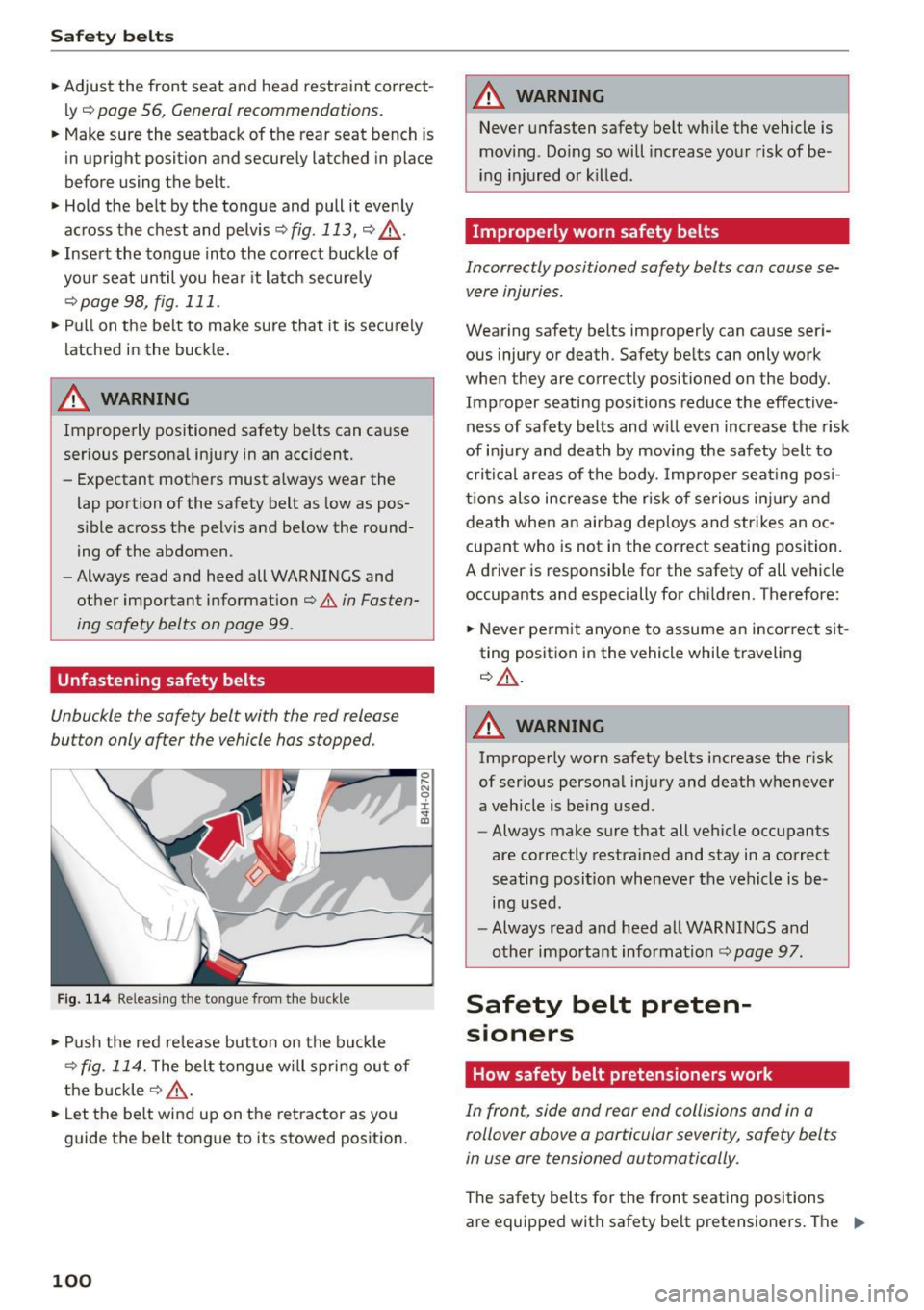
Safety belts
• Adjust the front seat and head restraint correct
ly
c::> page 56 , General recommendations .
• Make sure the seatback of the rear seat bench is
in upright position and secure ly latched in place
before using the belt.
• Hold the be lt by the tongue and pull it evenly
across the chest and pelvis
c::> fig . 113 , c::> _&..
• Insert the tongue into the correct buckle of
you r seat until you hea r it latch securely
c::>page 98, fig. 111 .
•Pullon the belt to make sure that it is securely
latched in the buck le .
A WARNING
-
Improperly positioned safety belts can cause
ser ious personal injury in an acc ident.
- Expectant mothers must a lways wear the
lap portion of the safety belt as low as pos
sible across the pelv is and below the round
ing of the abdomen.
- Always read and heed all WARNINGS and
other important information
c::> A in Fasten
ing safety belts on page
99 .
Unfastening safety belts
Unbuckle the safety belt with the red release
bu tton only ofter the vehicle hos stopped .
Fig. 114 Relea sing the tongue from the buckle
• Pu sh the red re lease button on the buckl e
c::> fig. 114. The belt tongue wi ll spring ou t of
the buckle
c::> ,&.
• Let the belt wind up on the retractor as you
guide the belt tongue to its stowed position .
100
0 .... N
0
:i: .,. lXl
A WARNING
Never unfasten safety be lt while the vehicle is
moving . Do ing so will increase your risk of be
ing injured or killed.
Improperly worn safety belts
Incorrectly positioned safety belts con cause se
vere injuries.
Wearing safety belts improperly can cause seri
ous injury or death . Safety belts can only work
when they are correctly positioned on the body.
Improper seating positions reduce the effective
ness of safety belts and wi ll even increase the risk
of injury and death by mov ing the safety belt to
critical areas of the body. Imp roper seat ing pos i
tions also increase the risk of serious injury and
death when an airbag deploys and strikes an oc
cupant who is not in the correct seating position.
A driver is responsible for the safety of all vehicle
occupants and especially for chi ldren . Therefore:
• Never permit anyone to assume an incorrect sit
ting positio n in the vehicle while travel ing
c::> _&. .
A WARNING
Improperly worn safety belts increase the r isk
of serious personal injury and death whenever
a veh icle is being used .
- Always make sure that all vehicle occupants
are correctly restrained and stay in a correct
seating position whenever the vehicle is be
ing used .
- Always read and heed all WARNINGS and
other important information
c::> page 97.
Safety belt preten-
.
s1oners
How safety belt pretensioners work
In front, side and rear end collisions and in a
rollover above a particular severity, saf ety belts
in use are tensioned automatically .
The safety belts for the front seating positions
are equipped with safety belt pretensioners. The ..,.
Page 103 of 232
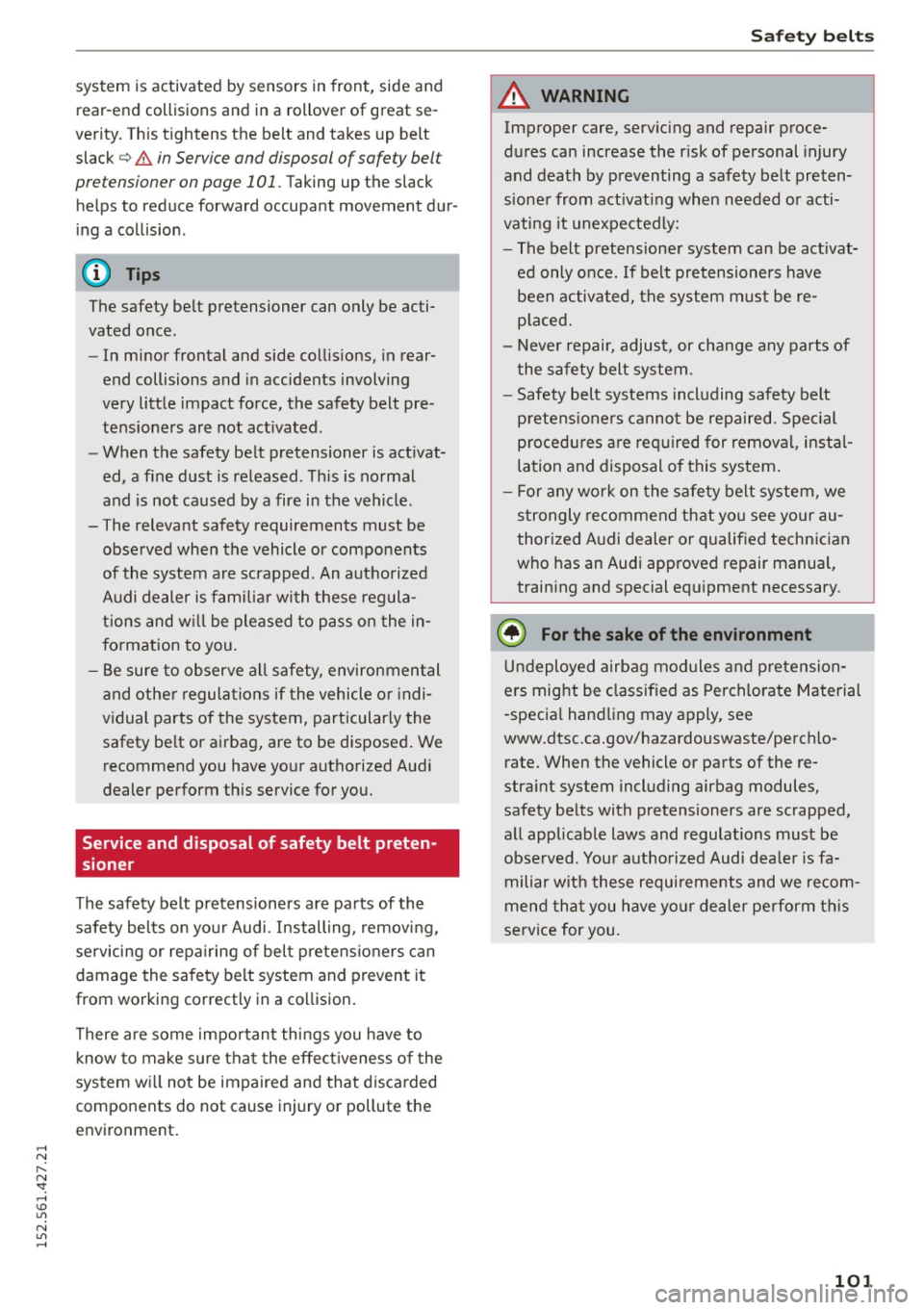
..... N
r-N "': ..... \!) 1.1'1
N 1.1'1 .....
system is activated by sensors in front, side and
rear-end collisions and in a rollover of great se
verity. Th is tightens the belt and takes up belt
slack <=>&.
in Service and disposal of safety belt
pretensioner on page 101.
Taking up the slack
helps to reduce forward occupant movement dur
ing a collision.
(D Tips
The safety belt pretensioner can only be acti
vated once.
-In minor frontal and side collisions, in rear
end collisions and in accidents involving
very little impact force, the safety belt pre
tensioners are not activated .
- When the safety belt pretensioner is activat
ed , a fine dust is released . This is normal
and is not caused by a fire in the vehicle.
- The relevant safety requirements must be
observed when the vehicle or components
of the system are scrapped . An authorized
Audi dealer is familiar with these regula
tions and w ill be pleased to pass on the in
formation to you.
- Be sure to observe all safety, environmental
and other regulations if the vehicle or indi
vidual parts of the system, particularly the
safety belt or airbag, are to be disposed . We
recommend you have your authorized Audi
dealer perform this service for you.
Service and disposal of safety belt preten
sioner
The safety belt pretensioners are parts of the
safety be lts on your Audi . Installing, removing ,
servicing or repairing of belt pretensioners can
damage the safety belt system and prevent it
from working correctly in a collision.
There are some important things you have to know to make sure that the effectiveness of the
system wil l not be impaired and that discarded
components do not cause injury or pollute the
environment .
Safety belts
A WARNING
-
Improper care, servicing and repair proce
dures can increase the risk of personal injury
and death by preventing a safety belt preten
sioner from activating when needed or acti
vating it unexpectedly:
- The belt pretensioner system can be activat
ed only once. If belt pretensioners have
been activated, the system must be re
placed.
- Never repair, adjust, or change any parts of
the safety belt system.
- Safety belt systems including safety belt
p retens ioners cannot be repaired. Special
procedures are required for removal, instal
lation and disposal of this system.
- For any work on the safety belt system, we
strongly recommend that you see your au
thorized Audi dealer or qualified technician
who has an Audi approved repair manual,
training and special equipment necessary.
@ For the sake of the environment
Undeployed airbag modules and pretension
ers might be classified as Perchlorate Material
-special handling may apply , see
www .dtsc.ca.gov/hazardouswaste/perchlo
rate. When the vehicle or parts of the re
straint system including airbag modules,
safety belts with pretensioners are scrapped,
all applicable laws and regulations must be
observed. Your authorized Audi dealer is fa
miliar with these requirements and we recom
mend that you have yo ur dealer perform th is
service for you.
101
Page 104 of 232
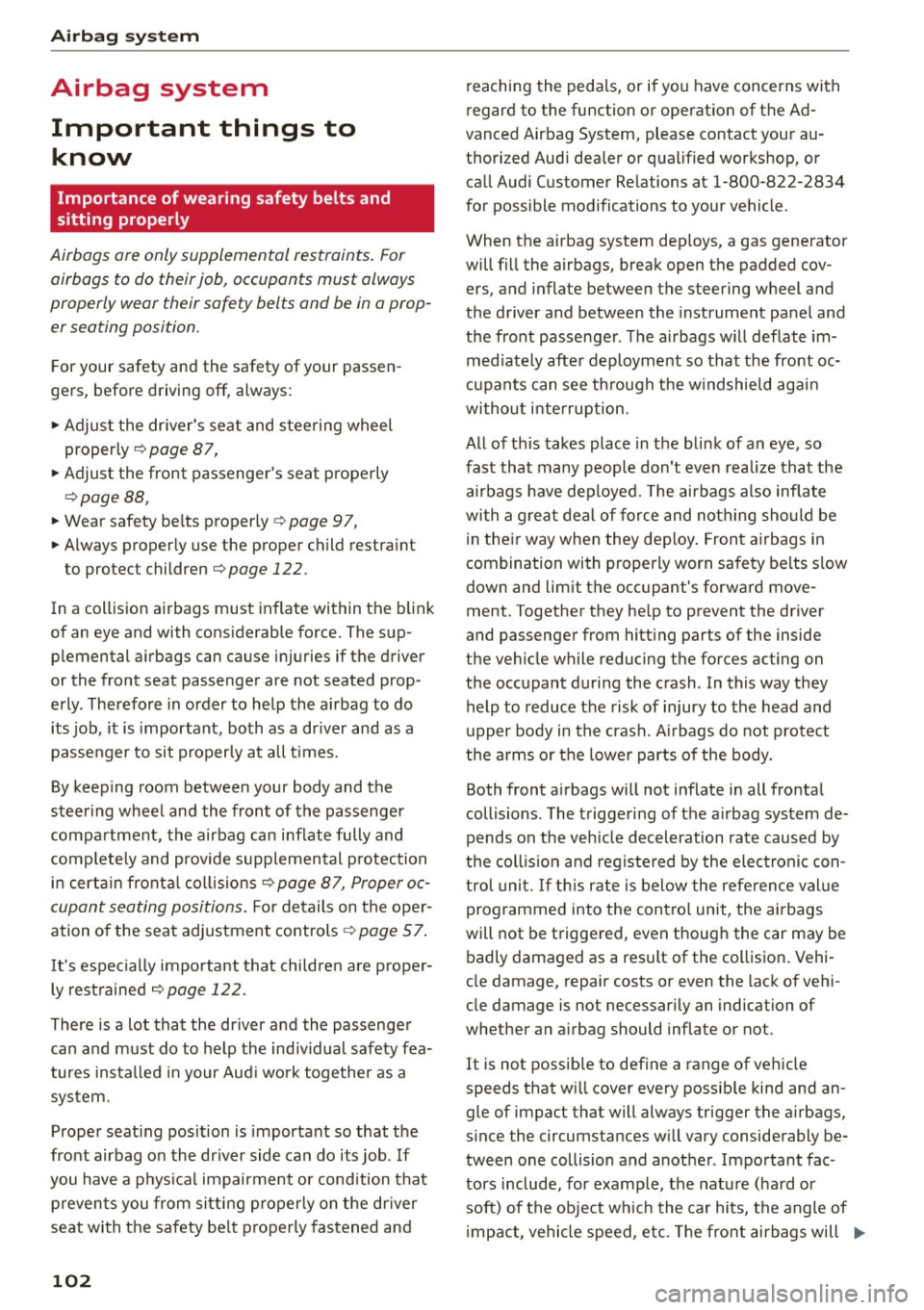
Airbag syste m
Airbag system
Important things to know
Importance of wearing safety belts and
sitting properly
Airbags are only supplemental restraints . For
airbags to do their job , occupants must always
properly wear their safety belts and be in a prop
er seating position.
For your safety and the safety of your passen
gers, before driving off, always:
.,. Adjust the dr iver's seat and steering wheel
proper ly ¢
page 87,
.,. Adjust the front passenger's seat properly
¢ page 88,
.,. Wear safety be lts proper ly ¢ page 9 7,
.,. Always properly use the proper child restra int
to protect children ¢
page 122.
In a collision airbags must inflate within the b link
of an eye and with cons iderable force. The sup
plemental a irbags can cause injuries if the driver
or the front seat passenger are not seated prop
erly . Therefore in order to help the airbag to do
its job, it is important, both as a dr iver and as a
passenger to sit properly at all times.
By keep ing room between your body and the
steer ing wheel and the front of the passenger
compartment, the airbag can inflate fully and
comp lete ly and provide supp lemental p rotec tion
in certa in fronta l co llisions ¢
page 87, Proper oc
cupant seating positions . For details on the oper
ation of the seat adjustment controls¢
page 57.
It's especially important t hat childre n are p roper
ly res trained
¢ page 122.
There is a lot that the driver and the passenger
can and must do to help the ind iv idual safety fea
tures insta lled i n your Aud i work together as a
system.
Proper seat ing pos ition is important so that t he
front airbag on the dr iver side can do its job . If
you have a p hys ica l impairment o r condition that
p revents you from sitt ing p roperly on the driver
seat with the safety be lt properly fastened and
102
reaching the pedals, or if you have concerns with
regard to the function or operatio n of the Ad
vanced Airbag System, please contact your a u
thori zed Audi dea ler or qua lified workshop, or
call Audi Customer Re lations at 1-800-822-2834
for poss ible modifications to your vehicle .
When the airbag system dep loys, a gas generator
will fill the airbags, break open the padded cov ers, and inflate between the steering wheel and
the driver and between the instrument panel and
the front passenger . Th e airbags w ill deflate im
med iate ly after deployment so that the front oc
cupants can see t hrough the w indshield aga in
without i nte rruption .
All of th is takes place in the blink of an eye , so
fast that many people don't even realize that the
a irbags have deployed. The airbags also inflate
with a grea t deal of force and nothing sho uld be
i n the ir way when they dep loy. Front a irbags in
combination with properly worn safety belts s low
down and limit the occ upant's forward move
ment . T ogether they he lp to prevent the driver
and passenger from hitt ing parts of the inside
the ve hicle while reducing the forces ac ting on
the occupant during the crash . In this way they
help to reduce the risk of injury to the head and
upper body in the crash. A irbags do not protect
the arms o r the lowe r parts of the body.
Both front a irbags w ill not inflate in all fronta l
collisions. The t rigge ring of the a irbag system de
pends on the veh icle deceleration rate caused by
the coll is ion a nd registe red by the elec tronic con
trol uni t. If th is rate is below the reference val ue
programmed into the contro l unit , the airbags
will not be t rigge red , even thoug h the car may be
badly damaged as a result of t he collisio n. Vehi
cle damage, repair costs or even the lack of vehi
cle damage is not necessarily an indication of
whether an a irbag should infla te or not .
It is not possib le to define a range of vehicle
speeds that w ill cover every possib le kind and an
gle of impact that will always trigger the a irbags,
s ince the circums tances w ill vary considerably be
tween one collision and another . Important fac
tors include, for example, the natu re (ha rd or
soft) of the object wh ic h the car hits, the angle of
i mpact, vehicle speed , etc. The front airbag s will .,.
Page 105 of 232
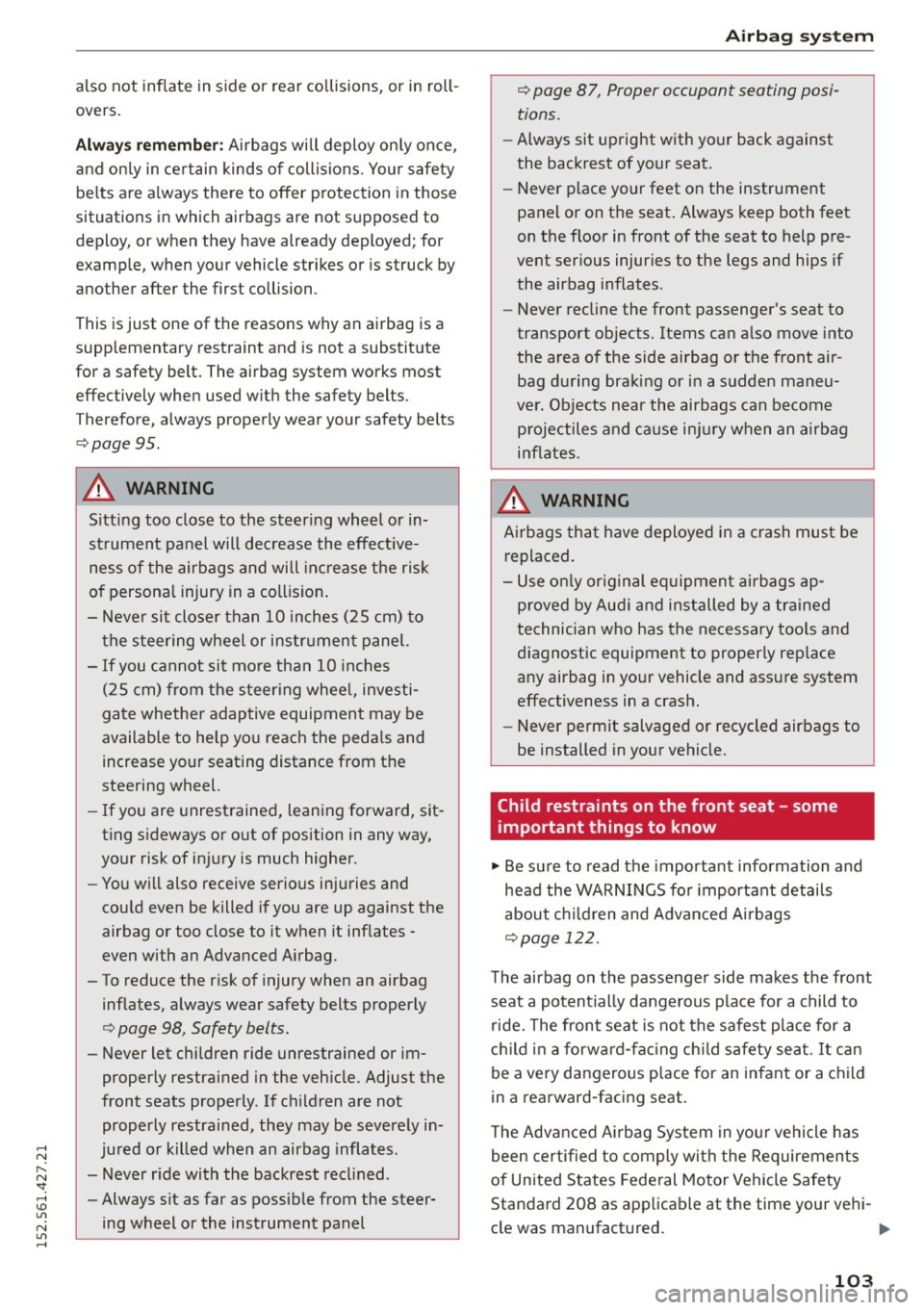
..... N
r-N "': ..... \!) 1.1'1
N 1.1'1 .....
also not inflate in side or rear co llisions, or in roll
overs .
Alwa ys rememb er: Airbag s wi ll deploy on ly once,
and on ly in cer tain kinds of collisions. Your safety
b e lts a re a lways there to offer protection in those
situations in which airbags are not supposed to
deploy, or when they have already deployed; for
examp le, when your vehicle str ikes or is struck by
another after the first collision .
This is just one of the reasons why an airbag is a
supp lementary restraint and is not a substitute
for a safety belt. The airbag system works most
effectively when used w ith the safety belts.
Therefore, always properly wear your safety belts
c::>page 95.
A WARNING
Sitting too close to the steer ing whee l or in
st rument panel will decrease the effect ive
ness of the airbags and will in cr ease the risk
o f persona l injury in a coll is ion .
- Never sit closer than 10 inches ( 25 cm) to
the steering wheel or instrument panel.
- If you cannot sit mo re than 10 in ches
( 2 5 cm) from the steer ing whee l, investi
gate whethe r adaptive equipmen t may be
available to help yo u reach the peda ls and
increase your seating distance from the
steering wheel.
- If you are unrestrained, lean ing forward, sit
ting s ideways or out of position in any way,
your risk of in jury is much higher.
- Yo u will also receive serio us injuries and
cou ld even be killed if you are up against the
airbag or too close to it when it inf lates -
even with an Advanced Airbag.
- To reduce the r isk of injury when an airbag
inflates, always wear safety belts properly
i=> page 98, Safety belts.
- Never let children ride unrestrained or im
properly restrained in the veh icle. Adjust the
front seats properly. If ch ildren are not
properly restrained, they may be severely in
jured or killed when an airbag inflates .
- Never r ide with the backrest recl ined .
- Always s it as far as possib le from the steer-
ing wheel or the instrument panel
-
Airbag syste m
c::> page 87, Proper occupant seating posi
tions.
- Always sit upright with your back against
the backrest of your seat.
- Never p lace your feet on the instrument
panel or on the seat. Always keep both feet
on the floor in front of the seat to help pre
vent ser ious injuries to the legs and hips if
the airbag inflates.
- Never recline the front passenger 's seat to
transport objects. Items can also move into
the area of the side airbag or the front air bag du ring bra king or in a sudden maneu
ver. Objects near the airbags can become p rojectiles and cause in ju ry when an airbag
inflates.
A WARNING
A irb ags th at have deployed i n a crash mus t be
r eplaced.
- Use on ly orig inal equipment airbags ap
p roved by Aud i and installed by a tr ained
technician who has the necessary too ls and
diagnostic equipment to properly rep lace
any airbag in yo ur vehicle and assu re system
effectiveness in a crash.
- Never permit salvaged or recycled airbags to
be installed in your vehicle.
Child restraints on the front seat -some
important things to know
"' Be sure to read the important information and
head the WARNINGS for important details
about c hildren and Advanced Airbags
c::>page 122.
The airbag on the passenger s ide makes the front
seat a potent ially dangerous p lace for a child to
r ide. The front seat is not the safest p lace for a
c hi ld in a forwa rd-fac ing c hild safety seat.
It can
be a ve ry dangero us p lace for an infant or a c hild
in a rearward-facing seat.
T he Adva nced A irbag Sys tem in you r vehicle has
been certified to comply wi th the Requiremen ts
of United States Federal Motor Vehicle Safety
Standard 208 as applicable at the time your ve hi-
cle was manufactured. ..,.
103
Page 106 of 232
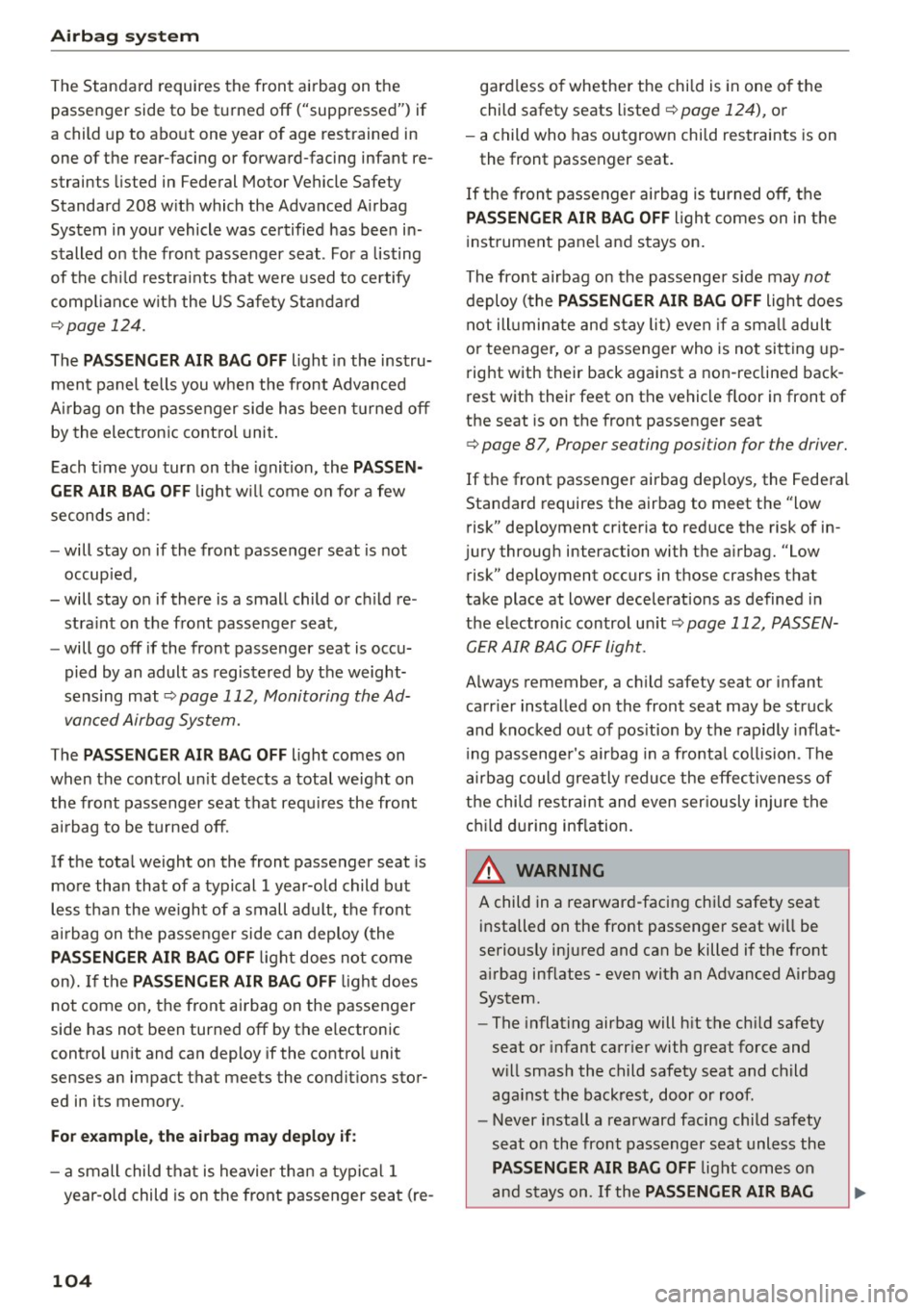
Airbag system
The Standard requires the front airbag on the
passenger side to be turned off ("suppressed") if
a child up to about one year of age restrained in
one of the rear-facing or forward-facing infant re
straints listed in Federal Motor Vehicle Safety
Standard 208 with which the Advanced Airbag
System in your vehicle was certified has been in
stalled on the front passenger seat. For a listing
of the child restraints that were used to certify
comp liance with the US Safety Standard
¢page 124.
The PASSENGER AIR BAG OFF light in the instru
men t panel tells you when the front Advanced
A irbag on the passenger side has been turned off
by the electronic control unit.
Each time you turn on the ignition, the
PASSEN
GER AIR BAG OFF
light w ill come on for a few
seconds and:
- will stay o n if the front passenger seat is not
occupied,
- will stay on if there is a small child or ch ild re
stra int on the front passenger seat,
- will go off if the front passenger seat is occu
pied by an adult as registered by the weight
sensing mat¢
page 112, Monitoring the Ad
vanced Airbag System.
The PASSENGER AIR BAG OFF light comes on
when the control un it detects a total weight on
the front passenger seat that requires the front
a ir bag to be turned off.
If the total weight on the front passenger seat is
more than that of a typical 1 year-old child but
less than the we ight of a small adult, the front
a ir bag on the passenger side can deploy (the
PASSENGER AIR BAG OFF light does not come
on) . If the
PASSENGER AIR BAG OFF light does
not come on, the front airbag on the passenger
side has not been turned off by the e lectronic
contro l unit and can deploy if the control unit
senses an impact that meets the conditions stor
ed in its memory.
For example, the airbag may deploy if:
-a small child that is heavier than a typical 1
year-old child is on the front passenger seat (re-
104
gardless of whether the child is in one o f the
child safety seats listed¢
page 124), or
- a child who has outgrown child restraints is on
the front passenger seat.
If the front passenger ai rbag is turned off, the
PASSENGER AIR BAG OFF light comes on in the
instrument panel and stays on.
The front airbag on the passenger side may
not
deploy (the PASSENGER AIR BAG OFF light does
not illuminate and stay lit) even if a smal l adult
o r teenager, or a passenger who is not sitting up
right with their back against a non-reclined back
rest with their feet on the vehicle floor in front of
the seat is on the front passenger seat
¢ page 87, Proper seating position for the driver.
If the front passenger airbag deploys, the Federal
Standard requires the airbag to meet the "low
risk" deployment criteria to reduce the risk of in
ju ry through interaction with the a irbag. "Low
risk" deployment occurs in those crashes that
take place at lower decelerations as defined in
the electronic control un it
¢page 112, PASSEN
G£R AIR BAG OFF light.
Always remember, a child safety seat or infant
carr ier installed on the front seat may be struck
and knocked out of position by the rapidly inflat
in g passenge r's airbag in a frontal collision . The
a irbag could greatly reduce the effec tiveness of
the child res traint and even seriously injure the
child during inflation.
_&. WARNING
A child in a rearward-facing chi ld safety seat
installed on the front passenger seat will be
seriously injured and can be killed if the front
a ir bag inflates -even with an Advanced Airbag
System.
- The inflating airbag will hit the ch ild safety
seat or infant carrier with great force and
will smash the child safety seat and child
aga inst the backrest, door or roof.
- Never install a rearward facing child safety
seat on the front passenger seat unless the
PASSENGER AIR BAG OFF light comes on
and stays on. If the
PASSENGER AIR BAG
Page 107 of 232
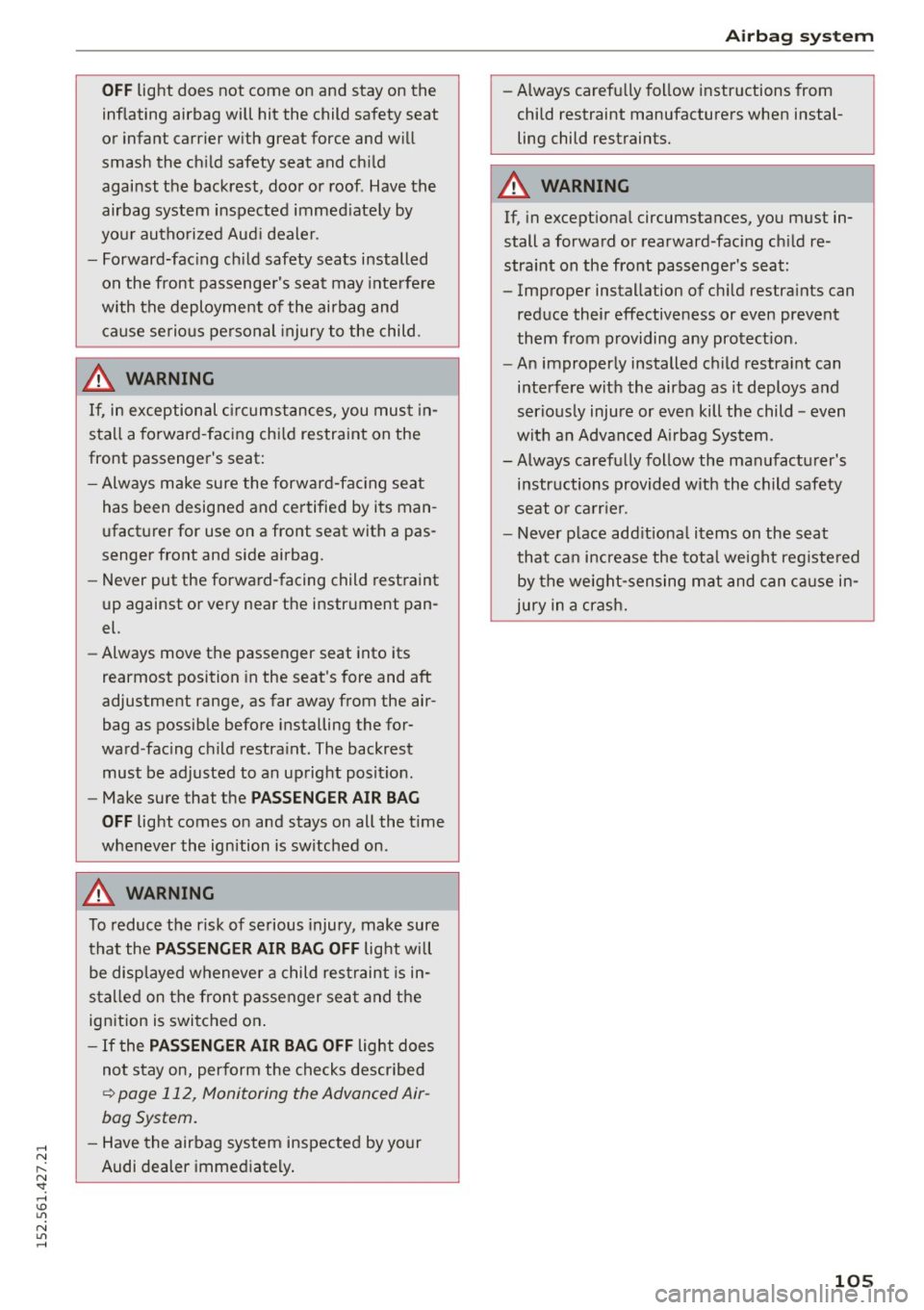
..... N
r-N "': ..... \!) 1.1'1
N 1.1'1 .....
OFF light does not come on and stay on the
inflating airbag will hit the child safety seat
or infant carrier w ith great force and w ill
smash the ch ild safety seat and ch ild
against the backrest, door or roof . Have the
airbag system inspected immed iately by
your authorized Aud i dealer .
- Forward-fac ing ch ild safety seats installed
on the front passenge r's seat may inte rfe re
with the deployment of the airbag and cause se rious personal injury to the child .
A WARNING
If, in exceptional c ircumstances, you mus t in
stall a forward -facing ch ild restraint on the
front passenger's seat:
- Always make sure the forward-fac ing seat
has been designed and ce rtified by its man
ufact urer for use on a front seat with a pas
senger front and side airbag.
- Never put the forward-facing child restraint
up against or ve ry near the instr ument pan
el.
- Always move the passenger seat into its
rearmost position in the seat's fore and aft
adjustment range, as far away from the air
bag as possib le before installing the for
ward -fac ing child restra int. The backrest
must be adjusted to an up right posit io n.
- Make sure that the
PASSENGER AIR BAG
OFF
light comes o n and stays on all the t ime
whenever the ignition is switched on .
A WARNING
To reduce the risk of serious injury, make sure
that the
PASSENGER AIR BAG OFF light wi ll
be di splayed w henever a child res traint is in
stalled on the front passenger sea t and the
ign ition is swi tched on .
-If the PASSENGER AIR BAG OFF light does
not stay on, per form the checks described
<:? page 112, Monitoring the Advanced Air
bag System .
-Have the airbag system inspecte d by your
Audi dealer immed iately .
Airbag syste m
- Always carefu lly follow instr uctions from
child restraint manufacture rs when instal
ling child restrain ts.
A WARNING
If, in except iona l circumstances, you m ust in
stall a forwa rd or rearward -fac ing ch ild re
strai nt on the front passenger's sea t:
- Improper installation of ch ild restra ints can
red uce their effectiveness or even prevent
them from providing any protect ion.
- An improperly installed ch ild restra int can
interfere with the airbag as it deploys and
serio usly injure or even kill the child -even
wit h an Adva nced A irbag System.
- Always carefu lly follow the manufact urer's
instr uctions provided w ith th e child safety
seat o r carr ie r.
- Never p lace add itiona l items on the seat
that can increase the total weight reg iste red
by the we ight-sensing mat and can c ause in
jury in a cr ash.
105
Page 108 of 232
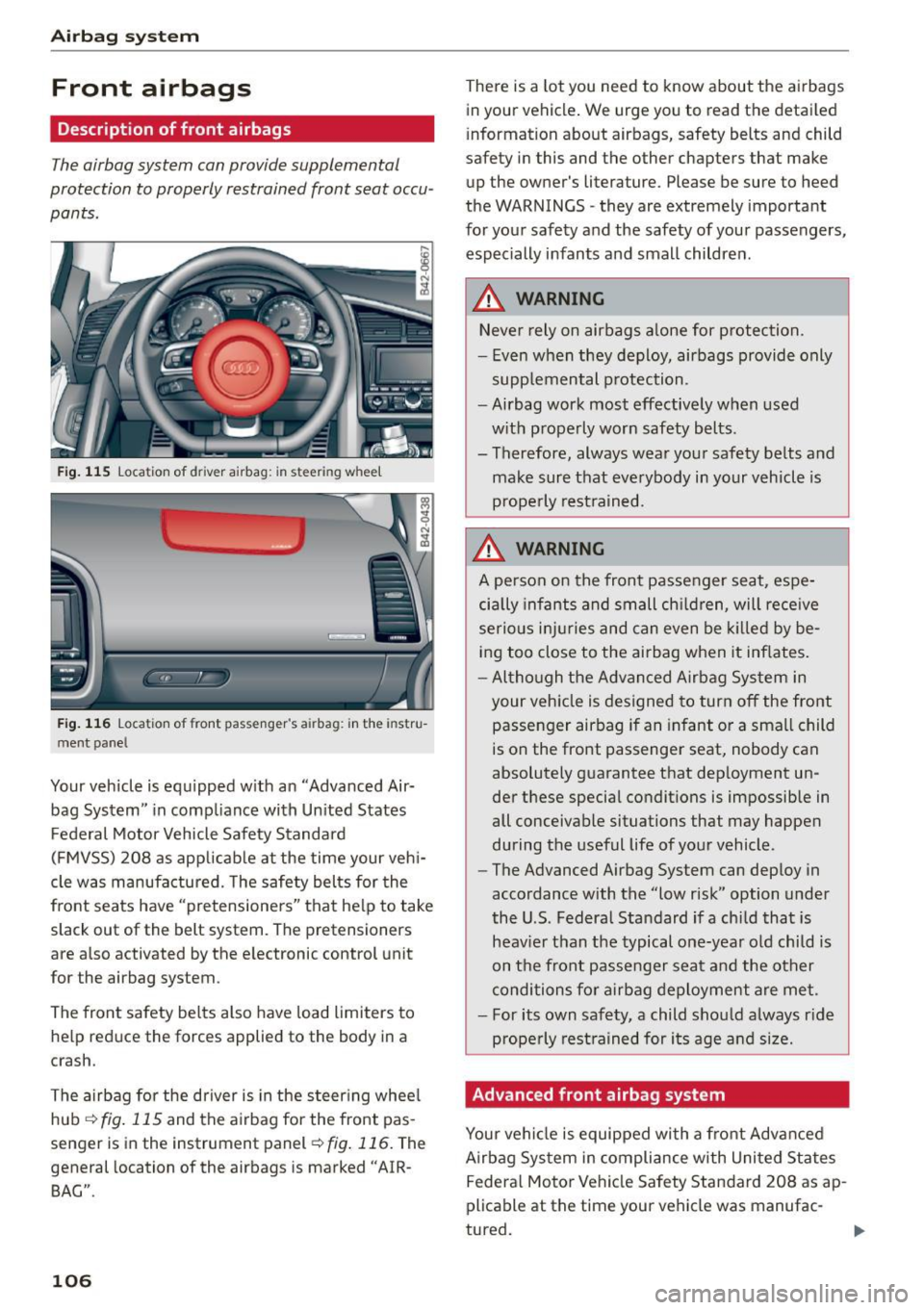
Airb ag syst em
Front airbags
Description of front airbags
The airbag system can provide supplemental
protection to properly restrained front seat occu
pants .
Fig. 115 Location of driver airbag : in steering whee l
Fig. 116 Location of front passenger's airbag: in the instru
ment panel
Your vehicle is equ ipped with an "Advanced Air
bag System" in comp liance with Un ited States
Federal Motor Vehicle Safety Standard
(FMVSS) 208 as applicab le at the time your veh i
cle was manufactured. The safety belts for the
front seats have "pretensioners" that he lp to take
slack out of the belt system. The pretensioners
are also activated by the electronic control unit
for the airbag system.
The front safety belts a lso have load limiters to
help reduce the forces applied to the body in a
crash.
The airbag for the driver is in the steer ing wheel
hub
¢ fig . 115 and the airbag for the front pas
senger is in the instrument panel¢
fig. 116. The
general location of the airbags is marked "AIR
BAG".
106
There is a lot you need to know about the airbags
in your vehicle . We urge you to read the detailed
i nformation about airbags, safety belts and child
safety in this and the other chapters that make
up the owner's literature. Please be sure to heed
the WARNINGS -they are extremely important
for your safety and the safety of your passengers, especially infants and small children .
,&_ WARNING -
Never rely on airbags alone for protection.
- Even when they deploy, airbags provide only supp lemental p rotection.
- Airbag work most effectively when used with properly worn safety belts .
- Therefore, always wear your safety be lts and
make sure that everybody in your vehicle is
prope rly restrained.
,&_ WARNING
A person on the front passenger seat, espe
cially infants and small ch ild ren, will rece ive
serious i njur ies and can even be killed by be
ing too close to the airbag when it inf lates .
- Although the Advanced Airbag System in your vehicle is designed to turn off the front passenger airbag if an infant or a sma ll child
is on the front passenger seat, nobody can
absolutely guarantee that dep loyment un
der these special condit ions is impossible in
all conceivable situations that may happen
during the useful life of your vehicle .
- The Advanced Airbag System can dep loy in
accordance with the "low risk" option under
the U .S. Federal Standard if a chi ld that is
heav ier than the typical one-year old child is
on the front passenger seat and the other
conditions for airbag deployment are met.
- For its own safety, a child shou ld always r ide
prope rly rest rained for i ts age a nd si ze.
Advanced front airbag system -
Your vehicle is equipped with a front Advanced
Airbag System
in compliance with United States
Federa l Motor Vehicle Safety Standard 208 asap
plicable at the time your vehicle was manufac
tured.
Page 109 of 232
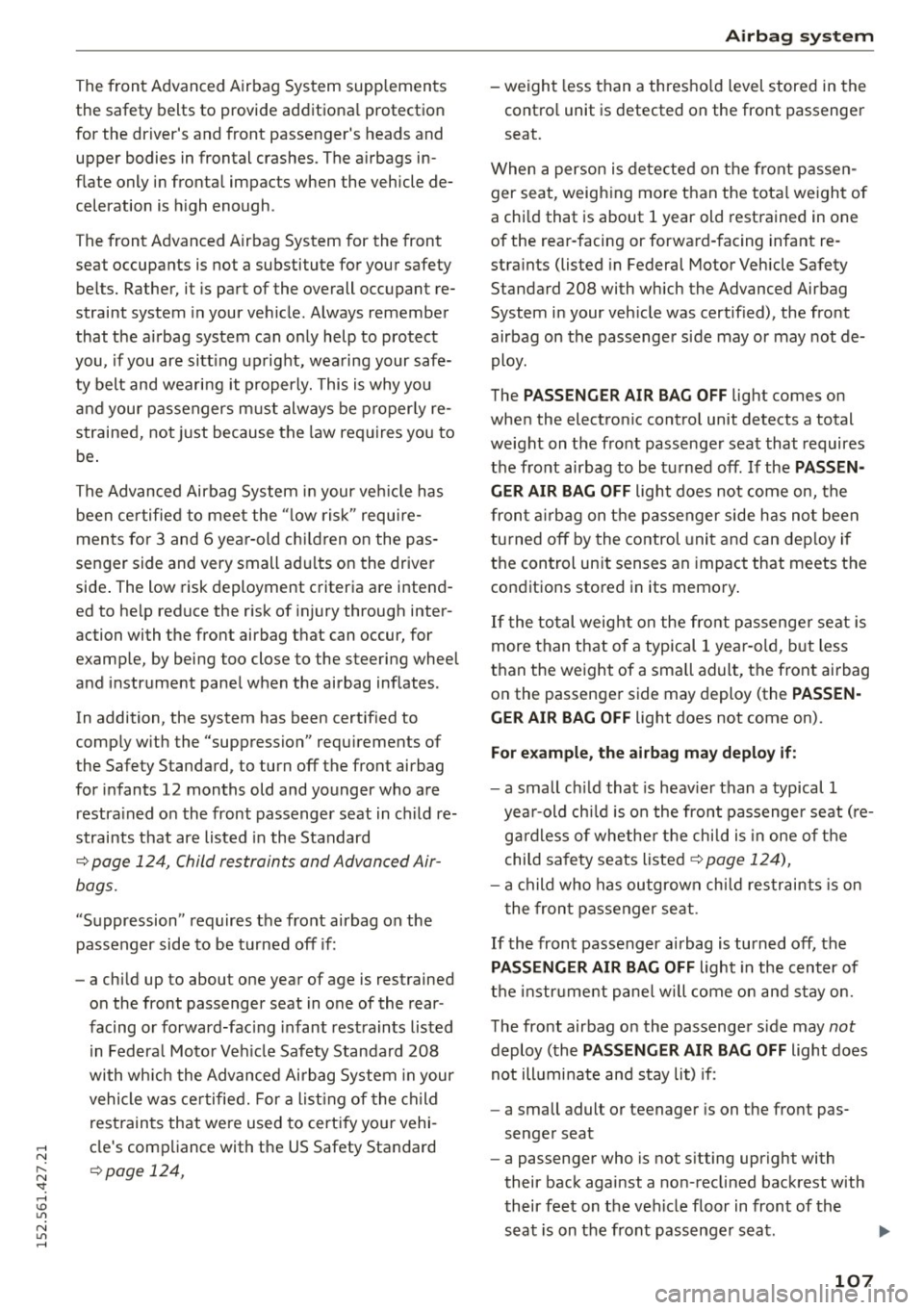
..... N
r-N "': ..... \!) 1.1'1
N 1.1'1 .....
The front Advanced Airbag System supp lements
the safety belts to provide additiona l protection
for the driver's and front passenger's heads and
upper bodies in frontal crashes. The a irbags in
flate only in frontal impacts when the vehicle de
celeration is h igh enough .
The front Advanced Airbag System for the front
seat occupants is not a substitute for your safety be lts. Rather, it is pa rt of the overall occupant re
straint system in your vehicle. Always remember
that the airbag system can only help to protect
you, if you are sitt ing upright, wearing your safe
ty belt and weari ng it properly. This is why you
and your passengers m ust always be properly re
strained, no t just because the law req uires you to
be .
The Advanced Airbag System i n your veh icle has
been certified to meet the " low risk " requi re
men ts fo r 3 and 6 yea r-old ch ildren on the pas
senger side and very small ad ults on the driver
side . The low risk deployment criteria are intend
ed to he lp reduce the r isk of injury through inter
action with the front airbag that can occur, for
examp le, by being too close to the steering wheel
and instrument pane l when the airbag inf lates.
In addition, the system has been certif ied to
comp ly w ith the "suppression" requ irements of
the Safety Standard, to turn off the front airbag
for infants 12 months old and younger who are restra ined o n the front passenger seat in c hild re
straints that are listed in the Standard
~ page 124, Child restraints and Advan ced Air
bags.
"S uppression" requires the front airbag on the
passenger side to be turned off if:
- a ch ild up to about one year of age is restrained
on the front passenger seat in one of the rear
facing o r forward-fac ing in fant rest raints listed
in Federa l Moto r Ve hicle Safety Standard
208
with wh ic h t he Advanced Ai rbag System in your
vehicle was cer tified. For a list ing of the ch ild
r es traints that were used to cert ify you r vehi
cle's compliance with t he US Safety Standard
~ page 124, Airbag
syste m
- weight less than a thresho ld level stored in the
cont ro l unit is detected on the front passenger
seat.
When a person is detecte d on the front passen
ger seat, weigh ing more than the tota l we ight of
a chi ld that is about 1 year old restrained in one
of the rear -facing or forwa rd-fac ing infant re
stra ints (listed in Federal Motor Vehicle Safety
Standard
208 with wh ich the Advanced Airbag
System i n your veh icle was certified), the front
airbag on the passenge r side may or may not de
ploy .
The
PASSENGER AIR BAG OFF light comes on
when the elect ro nic cont ro l unit detects a total
we ight on the fro nt passenger sea t that requires
the front airbag to be tu rned off . If the
PASSEN
GER AIR BAG OFF
light does not come on, the
fron t airbag on t he passenger side h as not bee n
tu rned off by the control unit and can dep loy if
t h e con trol unit senses an impact that meets t he
conditions stored in its memo ry .
If the tot al weight on the fr ont p assenge r seat is
more than that o f a typical 1 year-o ld, b ut less
t h an the weight of a small adult, the front airbag
o n the passenge r side may deploy (the
PASSEN
GER AIR BAG O FF
light does not come on).
For example , the airbag ma y deploy if:
- a small ch ild that is heav ie r than a typical 1
yea r-old ch ild is on the front passenge r seat ( re
ga rdless o f whether the chi ld is in one of the
child sa fe ty seats listed~
page 124),
-a child who has outgrown ch ild res traint s is on
t he fron t passenger seat.
If th e front passenger a irbag is turned off, the
PASSENGER AIR BAG OFF light in the center of
t h e instr ume nt pane l w ill come on and s tay on.
The front airbag o n the passenge r side may
not
deploy ( the PASSENGER AIR BAG OFF light does
not ill umi nate and s tay lit) if:
- a small adult or teenager is on the front pas
senger seat
- a passenger who is not s itting upright with
their back aga inst a non-reclined backrest with
their feet on the vehicle floor in front of th e
seat is on t he front passenger sea t.
IJl,
107
Page 110 of 232
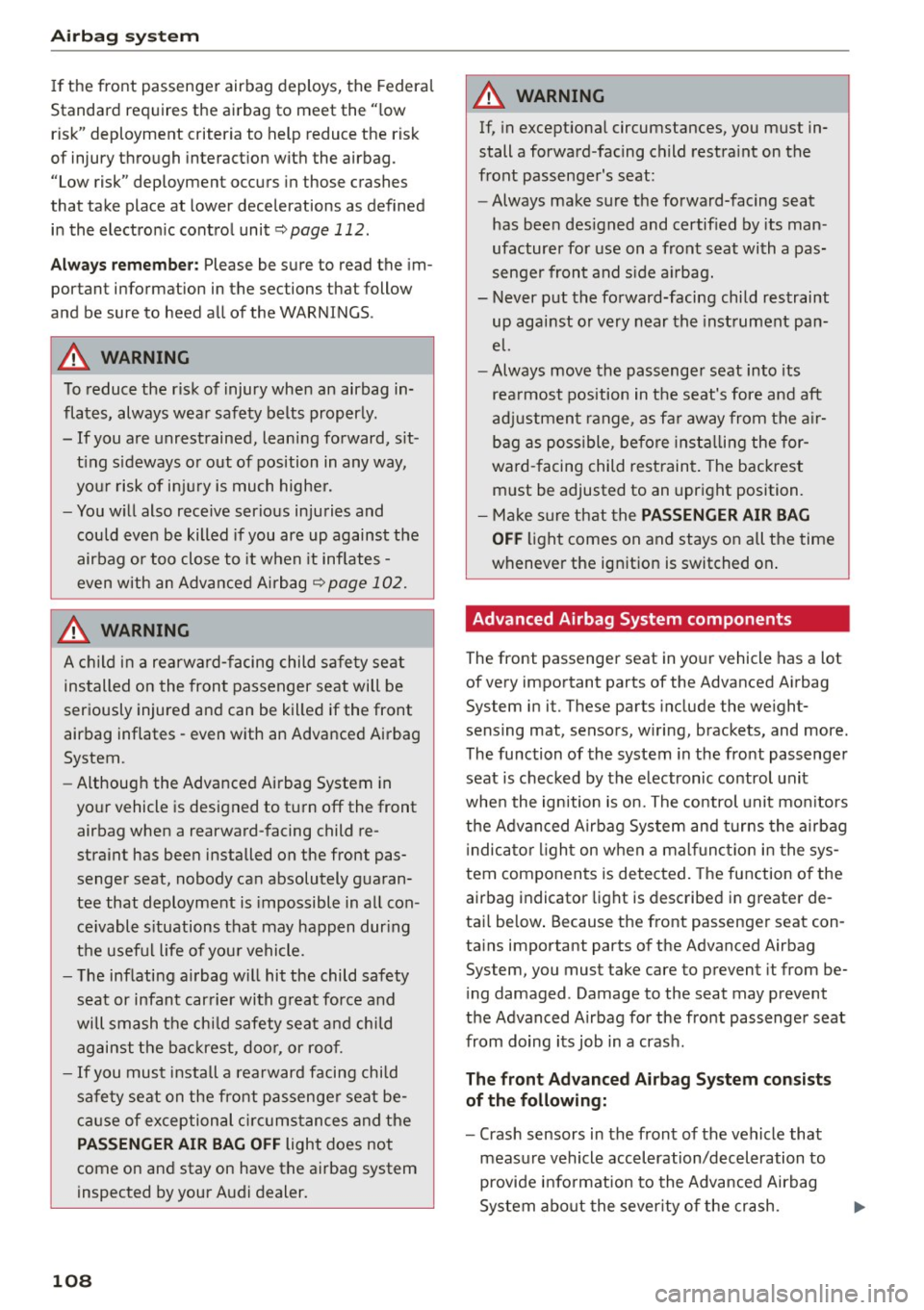
Airbag syste m
If the front passenger airbag deploys, the Federal
Standard requires the airbag to meet the "low
risk" deployment criteria to help reduce the risk
of injury through interaction with the airbag.
"Low risk" deployment occurs in those crashes
that take place at lower decelerations as defined in the electron ic control unit
<:;> page 112.
Always remember: Please be sure to read the im
portant information in the sections that follow
and be sure to heed a ll of the WARNINGS .
A WARNING
To reduce the risk of injury when an airbag in
flates, always wear safety belts properly.
- If you are unrestrained, leaning forward, sit
t ing s ideways o r out of position in any way,
you r risk of inju ry is much highe r.
- You w ill also receive serious injuries and
could even be killed if you are up against the
airbag or too close to it when it inflates -
even with an Advanced Airbag
<:;>page 102.
A WARNING
A child i n a rearward-facing child safety seat
installed on the front passenger seat will be
seriously injured and can be killed if the front
airbag inflates -even with an Advanced Airbag
System.
- Although the Advanced Airbag System in
yo ur vehicle is designed to turn off the front
airbag when a rearward-facing child re
straint has been installed on the front pas
senger seat, nobody ca n absolutely guaran
tee that deployment is impossible in all con
ceivable s ituations that may happen dur ing
the useful life of you r vehicle.
- The inflating a irbag w ill hit the child safety
seat or infant carrier with great force and
will smash the chi ld safety seat and chi ld
against the bac krest, doo r, or roof.
- If you must install a rearward facing child
sa fety seat on the front passenge r seat be
ca use of exceptional c ircumstances and the
PASSENGER AIR BAG O FF light does not
come on and stay on have the airbag system
inspected by your Audi dealer.
108
A WARNING , ~
If, in exceptiona l circumstances, you must in
stall a forward-facing child restra int on the
front passenger's seat:
- Always make sure the forward-facing seat
has been des igned and certified by its man
ufacturer for use on a front seat with a pas
senger front and s ide a irbag.
- Never put the forward-facing child restraint
up against or very near the inst rument pan
el.
- Always move the passenger seat into its
rea rmost position in t he seat's fore and aft
adjustment range, as fa r away from the a ir
bag as poss ible, be fore insta lling the for
ward-facing child restrain t. T he backrest
m ust be adjusted to an upr ight position.
- Ma ke s ure that the
PAS SENGER AIR BAG
OFF
li ght comes on and stays on all the time
wheneve r the ignition is switched on .
Advanced Airbag System components
The front passenger seat in your vehicle has a lot
of very important parts of the Advanced Airbag
System in it. These parts include the weight
sensing mat, sensors, wiring, brackets, and more.
The function of the system in the front passenger
seat is checked by the e lectronic control unit
whe n the ignition is on. The control unit mo nitors
the Advanced Airbag System and t urns the a irbag
i ndicator light on when a malf unct ion in the sys
tem components is detected. The function o f the
airbag indicator light is described in greater de
tai l below . Because the front passenger seat con
ta ins important parts of the Advanced Airbag
System, you must take care to prevent it from be
i ng damaged . Damage to the seat may prevent
the Advanced A irbag for the front passenger seat
from doing its job in a cras h.
The f ront Ad van ced Airbag S ystem consi sts
of the following:
- Crash sensors in the front of the vehicle that
measu re vehicle acceleration/deceleration to
provide i nfo rmation to the Advanced Airbag
System about the sever ity of the crash.